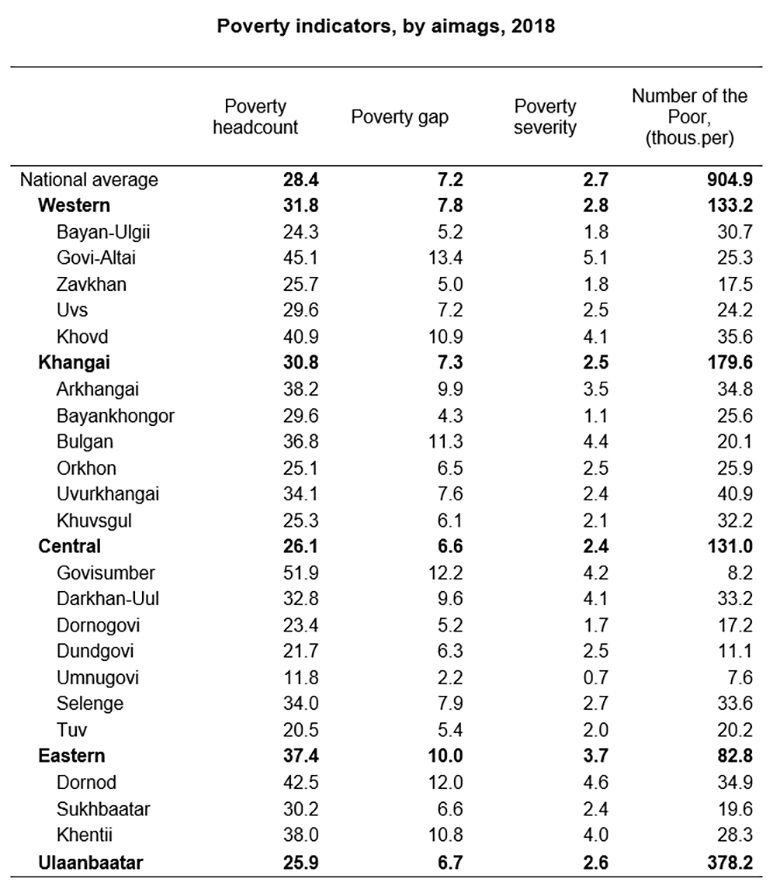Ulaanbaatar, June 21, 2019 - The National Statistics Office (NSO) of Mongolia and the World Bank today presented their joint poverty rate estimations for 2018. The two organizations have collaborated on poverty assessments through the Household Income and Expenditure Survey and the Living Standard Measurement Survey since 2002.
This time the poverty rate was estimated jointly on the basis of the 2018 Household Socio-Economic Survey. According to these estimates, the national poverty rate in Mongolia stood at 28.4 percent in 2018 – a decrease of 1.2 percentage points from the 2016 estimate of 29.6 percent.
In 2018, the poverty gap—which measures the depth of poverty by estimating how far off households are from the poverty line—was estimated at 7.2 percent, a decrease by 0.5 percentage point from 2016. Poverty severity, which measures the degree of inequality among the poor by putting more weight on the position of the poorest, has decreased to 2.7 percent from 2.9 percent in 2016.
Poverty concentration is growing in urban areas. During the period between 2016 and 2018, the poverty rate declined by 4.1 percentage points in rural areas but increased by 0.1 percentage point in urban areas. While poverty rate remains high in rural areas, with two-thirds of the total population of Mongolia living in urban cities, poverty has become concentrated in urban areas. The share of the poor population in urban areas has increased from 62.1 percent in 2016 to 63.5 percent in 2018, and more than 40 percent of the poor lived in Ulaanbaatar in 2018.
Regional poverty estimates show the decline in poverty rate by 6.6 percentage points in Eastern region, 4.3 percentage points in Western region, 2.7 percentage points in Khangai region, and by 0.7 percentage points in Central region. However, in Ulaanbaatar city the poverty rate increased by 1.1 percentage points.
At the aimag level, Govisumber in Central region has the highest poverty rate, where more than a half of the people are poor (51.9 percent), followed by Govi-Altai (45.1 percent), Dornod (42.5 percent) and Khovd (40.9 percent). On the other hand, Umnugovi has the lowest poverty incidence of 11.8 percent in Mongolia. In terms of number of the poor, Ulaanbaatar has by far the largest poor population (378.2 thousand) – nearly 10 times more than in Uvurkhangai, the aimag with the second highest number of the poor (40.9 thousand). Despite its highest incidence of poverty, Govisumber has one of the lowest number of the poor (8.2 thousand) due to its small population size.

In 2018, the monthly average consumption per capita was MNT 279,912, 3.9 percent higher than the price-adjusted real consumption per capita of MNT 269,328 in 2016. The growth of monthly per capita consumption during the period of 2016 to 2018 was higher in rural areas (5.4 percent) than in urban areas (3.7 percent).
The forthcoming poverty report with an in-depth socio-economic analysis of the 2018 living conditions in Mongolia will be released this fall.
Definitions:
The poverty line is derived from the 2010 Household Socio-Economic Survey using the cost of basic needs approach. The poverty line is set at the cost of acquiring a consumption bundle that provides 2100 calories per person per day as well as the cost of other non-food essential goods and services. The national poverty line was updated only for changes in price levels between surveys and the 2018 national poverty line is estimated at MNT 166,580 per person per month.
The poverty headcount index is the share of the population whose consumption is below the poverty line.
The poverty gap measures the depth of poverty. It is obtained by taking the mean distance below the poverty line as a proportion of the poverty line, with the non-poor being given a distance of zero.
The severity of poverty maesures the inequality (severity) among the poor. It is obitained by squearing the poverty gap, which means higher weights are placed on those who are further away from the poverty line.
Contacts
National Statistics Office
Government Building III,
Baga toiruu 44, Sukhbaatar district, Ulaanbaatar
+(976-51)-262325, 1900-1212
https://www.1212.mn, https://www.nso.mn
The World Bank Mongolia office
5th Floor, MCS Plaza Building
Seoul Street 4, 210644 Ulaanbaatar
https://www.worldbank.org/mongolia
+(976) 7007 8207
